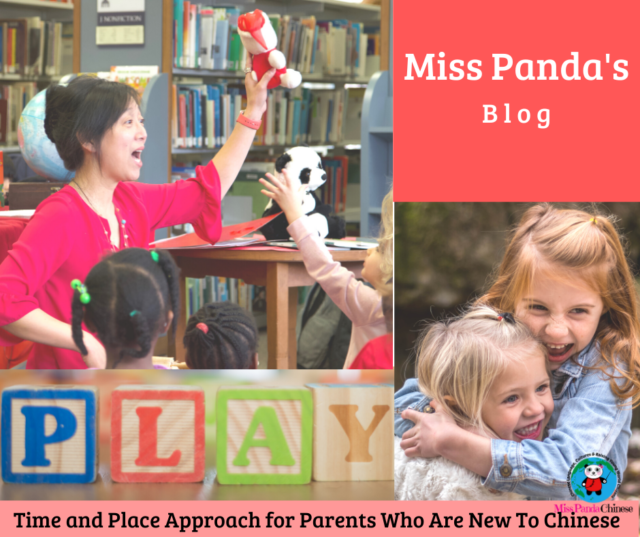
Raising bilingual kids is an exciting journey and there are different methods that you can use. Which method will work for your child and your family?
Do you need to be bilingual or have a high proficiency in the target language to introduce the language to your child? What if you are learning the Chinese language as you are teaching it to your child?
The goal for the parents is the same. Parents want to introduce a new language to the children at a young age and help the children gain proficiency in the target language.
It seems like there are more established methods for bilingual parents or multilingual parents. Here are the two popular methods:
One Person-One Language (OPOL)
- Each parent speaks her/his native language. (ex. Parent 1 speaks English, the native language of parent 1, and the parent 2 speaks Mandarin, the native language of parents 2.)
- One parent speaks his native language, the other parent speaks another language other than her native language which she has high proficiency in.
Minority Language At Home (MLAH/ML@H)
- Both parents speak their native language which is different from the community language. (ex. Both parents’ native language is Mandarin and the community language is English.) Both parents only speak their native language, the minority language at home. When the family is out they use the community language.
- Each parent speaks their native language, the minority language at home and in public.
But, is there a method for parents who don’t speak the target language?
Is there a method for parents who are learning the target language with their children at the same time?
Yes.
When parents are new to the target language, let’s take Mandarin Chinese as an example, the OPOL and MLAH methods are not easy to apply to the family. It is not an option most of the time. But, that does not prevent parents from helping their children to learn and acquire a new language.
Many parents have helped their children acquire a new language successfully without being bilingual themselves.
When I was teaching English in Taiwan most of the parents of my students only spoke Mandarin. These parents might have studied some English at school but they didn’t feel comfortable to have day-to-day conversations in English with their kids.
So, these parents went to the outside language resources in the community so they can add target language input to their children’s life before their children started learning English at school. At that time, Chinese students started formal English class in Grade 7, that was at age 12 or 13. This approach that parents adopted is called the Time and Place Approach.
Time and Place Approach for Parents Who Are New to the Chinese language
This is a method that parents who are new to the Chinese language can adopt. You can set up a time for Chinese and you can designate a place at home for Chinese. You can read a real family story in a coaching Q&A I had with a parent in the article here, The Time and Place approach is used by this parent and I explain how it can be arranged.
So, how can you implement the Time and Place method in your family?
-
Time:
Short and sweet is a good start. You can start with the length of a song. You can start with a few minutes of a PLAYFUL CHINESE podcast episode. It is about you and your child. Make it yours. Design it with your child’s joy in mind. You can expand the length of time as you go. Keep it short to start with.
-
Place:
A cozy place that your child enjoys spending time in.
-
Time and Place:
Combining the two. This works with a weekly Chinese tutor, an online Chinese program, a group Chinese class, and library Chinese storytime. They are all good examples of the Time and Place approach. There are a designated area and time slot for the above-mentioned programs. You can use a similar setup for your daily Chinese routine at home.
-
Practice:
It might feel not so natural at the beginning. That is because you are doing something new. It is like when you sit behind the wheel the first time and learn how to drive. Acknowledge it and know it is okay.
You will feel more comfortable as you practice. Make it a daily practice and be surprised by the progress you can make within a few weeks. The key is to start, that is, your first step. And, keep practicing every day.
-
Resource:
Children learn when they play. I cannot stress this enough. Playing is the best way to learn for kids. It is fun and it is relaxing. Is this how you learn best?
When Mandarin is not your native language you can listen to audio programs as a guide. Then practice what you have learned with your child. Keep things simple and relevant to your child’s everyday life.
What is your child’s current interest? What book are you reading to her? Classic children’s board books and pictures books are fun to listen to in Chinese. It is a way to get familiar with the sounds and tones of the Chinese language. Songs are a great way to start with baby, toddler, preschool, and kindergarten young learners. Big kids love songs, too. It is so much joy when we sing.
-
Be Like Water
Kids grow. The environment might change. But, your daily work makes the target language sustain, grow and thrive in your child. There should be room for flexibility as your child’s needs change at different ages.
Furthermore, the Time and Place approach is often used in multilingual families. And here are some examples.
-
A family lives in a foreign country other than the parents’ home country. For example, A family lives in France. Their child goes to a French school. Parent 1 speaks English and Spanish. Parent 2 is from China and this parent speaks Chinese and English fluently. The Time and Place approach is in place to ensure the language input of Chinese, Spanish, and English.
-
One example of this practice is to use Chinese after school and during dinner. Spanish is for every weekend mornings with Dad and the online calls with grandparents. Trilingualmama has a great article on this topic about how she manages three languages, English, Spanish, and French with her children living in France.
-
It is also a practice that can be applied in different contexts and situations. Language is active, therefore, it is flexible to work with your unique family bilingual language plan. One size does not fit all and you have the option to explore different techniques and use the one or a combo for your family.
From Time and Place approach it takes us to see one more way that many families use when there are two or more languages are used in the family or in the environment.
Mixed Languages
When there are multiple languages spoken at home or in the environment we often see the application of mixed languages in a household. In Quebec, Canada, many kids are exposed to both French and English at a young age. Parents might also use both languages at home, at work, and when they are meeting family and friends outside of the home. In this case, both languages are active in the lives of the children.
Being exposed to multiple languages does not guarantee a higher rate of becoming multilingual. The language input from parents at home plays a very important role.
The research conducted by the Belgian psycholinguist Annick De Houwer shows us some interesting findings and Linquist, Dr. Francois Grosjean shares it in The Languages You Speak To Your Bilingual Child.
Here are a few examples from Dr. Grosjean’s article.
One example is that both parents speak Dutch and the other language, but both parents only speak the other language at home.
Parent 1 speaks Dutch and the other language.
Parent 2 speaks Dutch and the other language.
What language they speak to their children: Both parents speak the other language to their children at home.
Result: There is a 97% transmission rate.
Another interesting example is when both parents speak both languages to their children.
Parent 1 speaks Dutch and the other language.
Parent 2 speaks Dutch and the other language.
What language they speak to their children: Both parents speak both languages to their children at home.
Result: The success rate is 79%.
You might be interested to know that the parents who use the One Parent One Language method reach the goal of helping their children become bilingual is 74%.
And, here is one more example mentioned in the same research.
Parent 1 speaks Dutch and the other language.
Parent 2 speaks Dutch only.
What language they speak to their children: One parent only speaks Dutch to the children. One parent speaks both Dutch and the other language to the children.
Result: The success rate is 36%.
Do you use the Time and Place approach for your family? Are you using mixed languages? What questions do you have when it comes to family language dynamics?

Image by Hannah Tasker